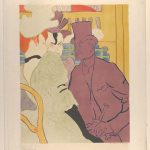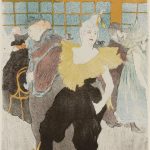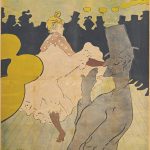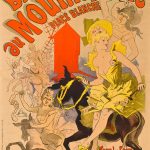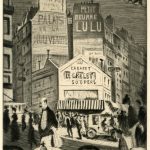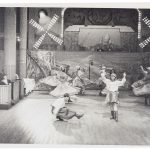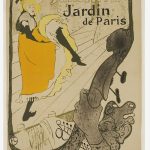Moulin Rouge is a cabaret in Paris, France.
The original house, which burned down in 1915, was co-founded in 1889 by Charles Zidler and Joseph Oller, who also owned the Paris Olympia. Close to Montmartre in the Paris district of Pigalle on Boulevard de Clichy in the 18th arrondissement, it is marked by the red windmill on its roof. The closest métro station is Blanche.
Moulin Rouge is best known as the birthplace of the modern form of the can-can dance. Originally introduced as a seductive dance by the courtesans who operated from the site, the can-can dance revue evolved into a form of entertainment of its own and led to the introduction of cabarets across Europe. Today, the Moulin Rouge is a tourist attraction, offering musical dance entertainment for visitors from around the world. The club’s decor still contains much of the romance of fin de siècle France.
Below are some examples of prints relating to the Moulin Rouge including posters by Henri de Toulouse-Lautrec and a gelatin print of dancers at the Moulin Rouge.
The Englishman at the Moulin Rouge 1892 Henri de Toulouse-Lautrec French
Printed by Edward Ancourt (French, 19th century)
Lithograph printed in six colors on laid paper
Reference: The Metropolitan Museum of Art
The Clowness at the Moulin Rouge La Clownesse au Moulin-Rouge Henri de Toulouse-Lautrec (French, 1864–1901) 1897
The female clown with the mock Chinese name Cha-u-ka-o (short for the dance chahut-chaos, a wild version of the cancan) walks arm in arm with a companion, Gabrielle-la-danseuse (Gabrielle the Dancer), at the Moulin Rouge.
Reference: Museum of Fine Arts Boston
Henri de Toulouse-Lautrec 1864 – 1901 MOULIN ROUGE – LA GOULUE (D. 339; ADR. 1.II; W. P1.A) Lithograph printed in colors, 1891, the two sheet version of Wittrock’s A (of D), on wove paper, printed by Affiches Americaines C.H. Levy, Paris, published by Charles Zidler, Paris, framed image: 1645 by 1170 mm 64 3/4 by 46 1/8 in sheet: 1707 by 1215 mm 67 1/4 by 47 7/8 in
Sold for 81,250 USD at Sotheby’s in 2015
JULES CHÉRET (FRENCH, 1836-1932) Bal au Moulin Rouge, Place Blanche (B. 309), 1889 Lithograph printed in colors, published by Chaix, Paris, framed. 32 1/2 x 23 1/4in (82.5 x 59cm)
Sold for US$ 2,000 (£ 1,618) inc. premium at Bonham’s in 2015
Place Blanche
City street scene in Paris viewed from café with waiter in foreground. 1922 Drypoint Print made by: Christopher Richard Wynne Nevinson
This etching was printed in an edition of 40. It is related to a painting in oil on canvas that was first exhibited at the Leicester Galleries, London in October 1921 (no. 25). A pastel version made in c.1922 was shown at the Leicester Galleries in March 1926 (no. 18).Jonathan Black notes: “Place Blanche is situated on the Boulevard de Clichy and faces the celebrated Moulin Rouge dance hall. The print was much admired when exhibited in Nevinson’s solo show of prints held at the Kraushaar Galleries, New York, in October 1926.” (‘C.R.W. Nevinson: The Complete Prints’, (Lund Humphries, 2014), no. 95, p. 163)
Reference: © The Trustees of the British Museum
ILSE BING (1899–1998) Images from Moulin Rouge, 1931 twelve gelatin silver prints eight signed and dated in black or white ink (recto); six signed and dated, two also titled, and each with Estate numbers, all in pencil (verso) each image: approximately 6 1/2 x 9 in. (16.5 x 22.8 cm.) or inverse each sheet: approximately 7 x 9 1/2 in. (17.8 x 24.1 cm.) or inverse
Sold for USD 15,000 at Christie’s in 2017
The Belle Époque was a period of peace and optimism marked by industrial progress, and a particularly rich cultural exuberance was about at the opening of the Moulin Rouge. The Expositions Universelles of 1889 and 1900 are symbols of this period. The Eiffel Tower was also constructed in 1889, epitomising the spirit of progress along with the culturally transgressive cabaret. Japonism, an artistic movement inspired by the Orient, with Henri de Toulouse-Lautrec as its most brilliant disciple, was also at its height. Montmartre, which, at the heart of an increasingly vast and impersonal Paris, retained a bucolic village atmosphere; festivities and artists mixed, with pleasure and beauty as their values. On 6 October 1889, the Moulin Rouge opened in the Jardin de Paris, at the foot of the Montmartre hill. Its creator Joseph Oller and his Manager Charles Zidler were formidable businessmen who understood the public’s tastes. The aim was to allow the very rich to come and ‘slum it’ in a fashionable district, Montmartre. The extravagant setting – the garden was adorned with a gigantic elephant – allowed people from all walks of life to mix. Workers, residents of the Place Blanche, artists, the middle classes, businessmen, elegant women, and foreigners passing through Paris rubbed shoulders. Nicknamed “The First Palace of Women” by Oller and Zidler, the cabaret quickly became a great success. Reference: Wikipedia
